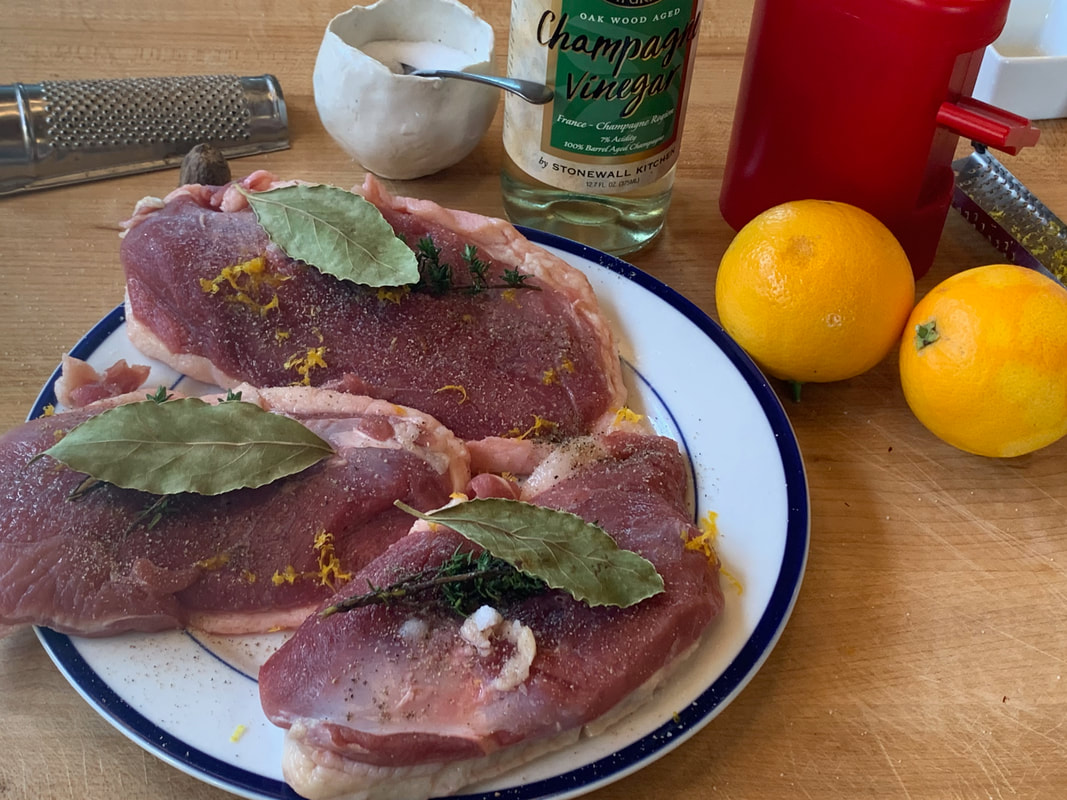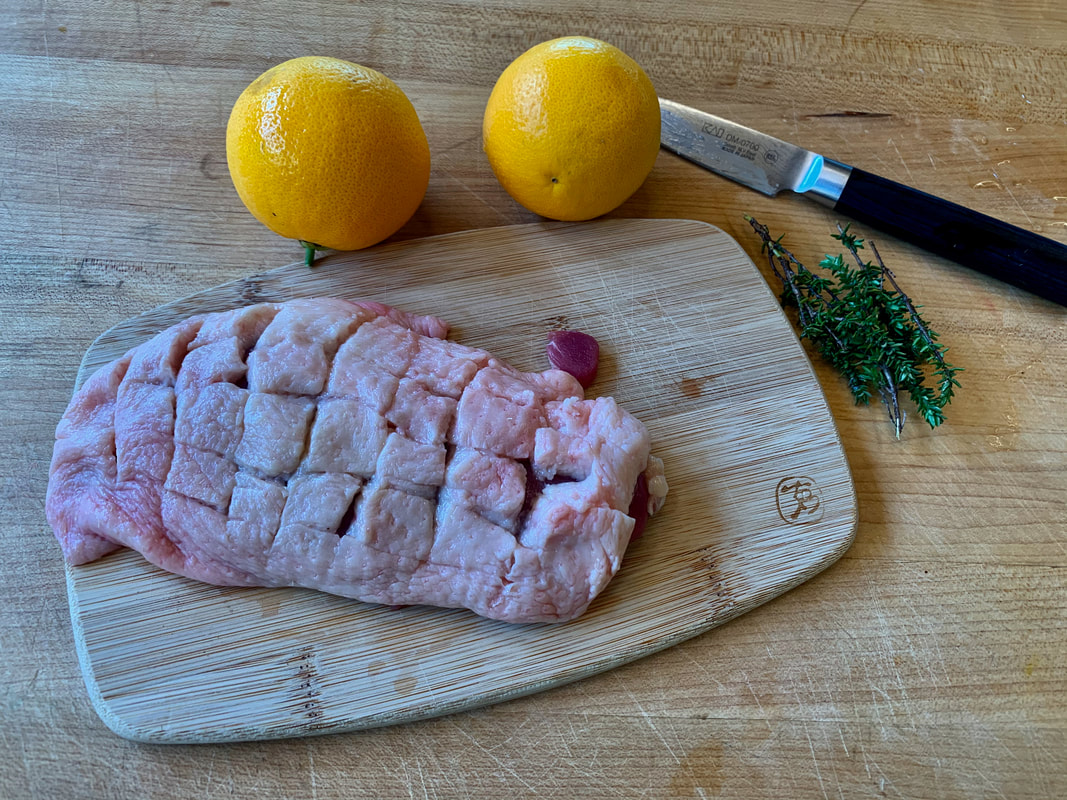|
Duck is my all-time favorite food. I am obsessed with duck confit. Because of that, I have neglected the succulent and tender duck breast, a delicacy that takes very little time and knowledge to prepare. Just follow a few simple steps and you will have an elegant and delicious dinner. Add your favorite vegetable and salad—and a your special dinner is ready. When I was planning my dinner with the duck breasts, I was looking for an alternative to my calorie-laden mashed potatoes or my fried potatoes in duck fat. I found a recipe for celery root purée that I like very much. It is from Dorie Greenspan’s book Around my French Table, and like so many of her recipes, it turned out great. I reduced the amount of butter by half. The duck breast and the purée complemented each other perfectly. Another time, I served it with my stuffed pasta shells. Several years ago, when I was at the culinary Institute in the Napa Valley, I bought Thomas Keller’s book ad hoc at home. It has many good recipes that I want to make. I used his recipes for duck breast several times over the years and have loved every bite. I tweaked the recipe just a little bit. I made this recipe during the pandemic with three small duck breasts. I think one medium-sized breast per person is plenty. One of the key elements to an excellent duck breast is crisping the skin properly. The skin needs to be scored so the fat can quickly render away. Cook the breasts slowly with the skin down, pouring off the fat as it cooks. Never, ever throw duck fat away. I keep mine in the fridge for months or freeze it and use it on my red cabbage or fried potatoes—and anything else I can think of. In this recipe, the duck breast is cured for up to 24 hours (adding spices and aromatics for the last 12 hours). THE RECIPE FOR SEARED DUCK BRESTIngredients: Serves 2 2-3 duck breasts (depending on size) 1 thyme twig per breast 1 bay leaf per breast 1 TBS orange zest for 2 breasts balsamic vinegar grated nutmeg 1 tsp canola oil grey salt or other coarse sea salt ½ cup of white wine Directions: One day before serving the breasts, defrost them. After they are defrosted, wipe the breast dry and put them on a plate uncovered skin up in the fridge for about 12 hours. To score the skin, the breasts have to be cold. Use a sharp knife, cutting a ¼-inch crosshatch pattern in the skin being careful not to pierce the meat. Season the flesh side of each breast with salt, pepper and a little bit of grated nutmeg. Sprinkle the orange zest and a few drops of balsamic vinegar over the breasts. Lay a thyme twig in the middle of each breast and cover it with a bay leaf. On a plate covered with a paper towel, turn the breasts over and put them on the paper towel. Sprinkle the skin side with salt, pepper and a pinch of nutmeg. Refrigerate, uncovered, for 1-12 hours (but at least one hour). I prepare mine the morning before I cook them, about 8 hours. Preheat the oven to 400 degrees Fahrenheit. Discard aromatic spices, blotting away any moisture from the duck breasts. Season both sides of the breast with a pinch of salt. In a large frying pan, add canola oil and the duck breasts duck skin-side down. Sauté at low-medium heat. After about 5 minutes, the fat should begin to gently bubble. Maintain this bubbling, removing excess rendered fat with a large spoon by tilting the frying pan. Be careful not to burn yourself. If the fat hits the flame, it will cause a flare-up. Cook the duck breasts until most of the fat has been rendered: the skin will be golden brown and crisp. The internal temperature should read 115 degrees Fahrenheit. Flip each breast to the fleshy side and cook it for 30 seconds. Put the duck skin-side down in the oven and cook for about 5 minutes. The temperature should be 125 degrees for a rosy medium rare. Take the duck breast out of the pan, cover it with foil and let it rest for 5 minutes. In the meantime, deglaze the frying pan by adding half a glass of white wine. Add any juices that have accumulated on your plate with the duck breasts to the sauce. If you like, add a little orange juice and swirl some butter into the sauce. (This step is optional.) Slice the duck breast and serve it with a vegetable you like. I envision some red cabbage with potatoes fried in duck fat. Pour some of the sauce over the duck. A citrus-flavored salad would be a nice addition. The possibilities are endless. Click here for my jumbo shells stuffed with Swiss chard and artichokes. Click here for Dorie Greenspan’s recipe for “Go-With-Everything Celery Root Puree.” This is a wonderful meal for a special person. Have fun, enjoy, and tell me if you liked it. Guten Appetit! Recipe by Thomas Keller Adapted by © Sunnycovechef.com Lemon Mousse (Zitronenspeise) would make a perfect light ending to a special meal. Almond pear tart would top it all off. You decide which one!
16 Comments
|
WELCOME TO SUNNY COVE CHEFThank you for visiting my blog. My two passions are cooking and traveling. Traveling exposes me to a wide variety of food and experiences. I walk around cities looking for markets, restaurants, bakeries, shops, you name it, and if it is related to food you will find me there, tasting, smelling, talking to vendors, and having a great time. Categories
All
Archives
February 2024
|









 RSS Feed
RSS Feed